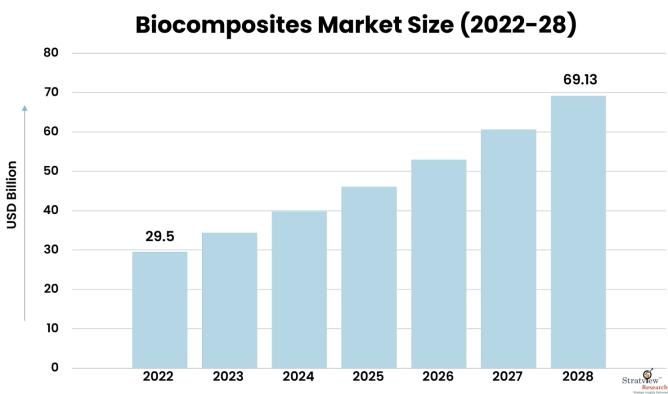Strategic Analysis of the Biocomposites Market: Trends and Forecasts

The global biocomposites market is experiencing significant growth, driven by increasing environmental concerns and the demand for sustainable materials. Biocomposites, which are made from natural fibers such as flax, hemp, jute, and recycled bio-based resins, have gained considerable attention across various industries due to their eco-friendly nature, lightweight properties, and comparable performance to traditional composites. This article explores the size, share, trends, competitive landscape, and growth opportunities in the biocomposites market from 2023 to 2028.
Market Size and Share
The Biocomposites Market is expected to grow from USD 29.5 billion in 2022 to USD 69.13 billion by 2028 at a CAGR of 15.00% during the forecast period. This expansion is driven by the increasing adoption of biocomposites in industries such as automotive, construction, packaging, and consumer goods, which are seeking environmentally friendly alternatives to synthetic composites.
The automotive industry is a significant consumer of biocomposites due to the increasing demand for lightweight and fuel-efficient vehicles. Additionally, the construction industry is adopting biocomposites for their durability, insulation properties, and low carbon footprint. The packaging sector is also seeing increased use of biocomposites in the production of sustainable packaging materials.
Key Trends
Several trends are influencing the growth of the biocomposites market:
- Sustainability Initiatives: Government regulations and corporate sustainability goals are pushing industries to adopt eco-friendly materials. Biocomposites align well with these initiatives, contributing to reduced carbon emissions and waste.
- Technological Advancements: Innovations in material science and manufacturing processes are enhancing the performance and cost-effectiveness of biocomposites, making them more competitive with traditional composites.
- Circular Economy: The concept of a circular economy, where materials are recycled and reused, is gaining traction. Biocomposites fit into this model, further driving their demand across industries.
Competitive Landscape
The biocomposites market is highly competitive, with key players including Trex Company, FlexForm Technologies, Tecnaro GmbH, UPM Biocomposites, and Green Dot Bioplastics. These companies are investing heavily in research and development to improve the performance and expand the application of biocomposites. Partnerships and collaborations with automotive and construction firms are also common strategies to gain a competitive edge.
Growth Opportunities
The Asia-Pacific region, particularly China and India, is expected to offer significant growth opportunities in the biocomposites market. These countries are experiencing rapid industrialization and urbanization, creating a demand for sustainable building materials and lightweight automotive components.
In Europe and North America, stringent environmental regulations are driving the adoption of biocomposites in various industries. The increasing awareness among consumers about the environmental impact of products is also contributing to market growth in these regions.
Conclusion
The biocomposites market is poised for robust growth from 2023 to 2028, driven by sustainability trends, technological advancements, and growing demand from various industries. With the ongoing shift towards environmentally friendly materials, biocomposites will continue to gain market share and play a vital role in the transition to a greener, more sustainable future.
- Art
- Causes
- Crafts
- Dance
- Drinks
- Film
- Fitness
- Food
- Games
- Gardening
- Health
- Home
- Literature
- Music
- Networking
- Other
- Party
- Religion
- Shopping
- Sports
- Theater
- Wellness


